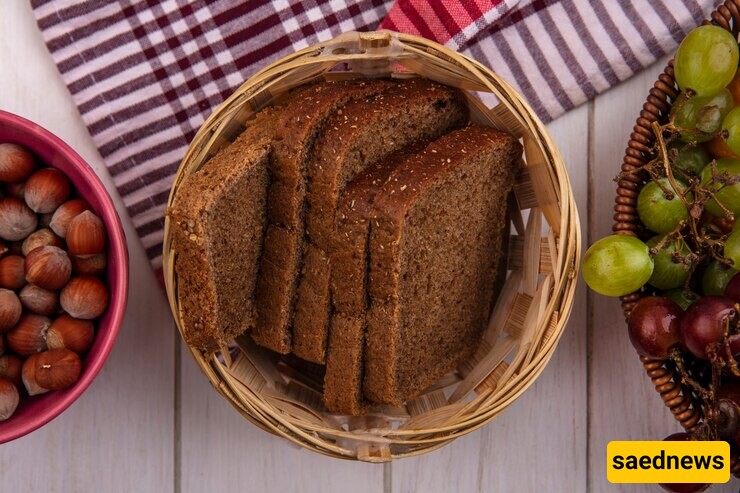SAEDNEWS: Grape molasses bread is one of the most delicious types of bread that can be enjoyed for breakfast, an afternoon snack, or as a school lunchbox treat.

According to SAEDNEWS, grape molasses bread is a nutritious and delicious type of bread that can be made with grape molasses, date molasses, or mulberry molasses. This bread is an excellent choice for breakfast, an afternoon snack, or a school recess treat. If you want to learn how to bake various types of bread with different flavors, join us in this article as we guide you through the steps to make grape molasses bread.

Warm milk: 2 cups
Grape molasses: 3 tablespoons
Flour: approximately 6 cups
Sugar: 3 tablespoons
Egg: 1
Cocoa powder: 1 tablespoon
Vegetable oil: 1 cup
Instant yeast: 1 tablespoon
Salt: 1 teaspoon
Preparation Time: 2 hours Baking Time: 30 minutes
Step 1: Activate the Yeast
In the first step, pour the milk into a saucepan and warm it over low heat. Transfer one cup of the warm milk to a suitable bowl, and add the yeast and sugar. The milk should be warm but not hot. Stir the mixture well and wait for about 10 minutes until the yeast is activated and frothy.
Step 2: Add Remaining Milk and Oil
Once the yeast is activated, add the remaining milk and vegetable oil to the bowl. Stir the mixture well until fully combined.
Step 3: Add Egg White
Separate the egg yolk and white. Reserve the yolk for brushing the bread later. Beat the egg white until frothy, and then fold it into the milk, sugar, yeast, and oil mixture.
Step 4: Prepare the Dough
Mix the salt and flour together. Gradually add this mixture to the bowl while folding the ingredients until a dough forms.
Step 5: Let the Dough Rest
Shape the dough into a ball, cover it with a clean, damp cloth, and let it rest in the kitchen for an hour and a half until it doubles in size.
Step 6: Shape the Dough
After the dough has risen, deflate it and divide it into 8 to 10 equal portions. Cover the dough portions with a damp cloth and let them rest for another hour.
Step 7: Fill and Roll the Dough
Preheat the oven to 180°C (350°F). Roll out each portion of dough with a rolling pin, and spread grape molasses and cocoa powder over it. Roll or shape the dough as desired. Place the filled dough on a baking sheet lined with parchment paper, and brush with the reserved egg yolk.
Step 8: Bake the Bread
Place the baking sheet in the middle rack of the preheated oven. Bake for about 20 to 30 minutes. In the final minutes of baking, switch the oven to broil to give the bread a golden color.
Final Step: Serve the Bread
Remove the freshly baked bread from the oven and wrap it in a clean cloth to keep it warm. You can serve this nutritious bread as a school snack, or enjoy it for breakfast or an afternoon snack with cheese, butter, clotted cream, or whipped cream.

You can substitute grape molasses with date molasses or mulberry molasses if desired.
You can omit the cocoa powder if you prefer.
You can mix the cocoa powder and molasses directly into the dough if desired.
For added flavor, you can add chopped walnuts and raisins to the dough.
Grape molasses bread, made with grape molasses and cocoa powder, is rich in vitamins, minerals, and beneficial compounds that provide energy and support overall health.
For instance, grape molasses contains high levels of antioxidants, sugars, iron, sodium, calcium, magnesium, potassium, and vitamins A, B, and C. These nutrients help provide the body with energy, combat stress, and boost the immune system. Regular consumption of grape molasses can also support children's growth and treat anemia.
Cocoa powder is rich in vitamins and minerals such as vitamins K, E, and A, folate, calcium, iron, magnesium, potassium, phosphorus, zinc, copper, manganese, selenium, fiber, protein, and riboflavin. These nutrients support brain function, memory, reduce the risk of diabetes, enhance physical performance, promote happiness, strengthen the immune system, and improve digestive health.
Therefore, grape molasses bread is a healthy and nutritious snack for school lunchboxes and recess.
If the Dough is Too Stiff:
Add a little warm milk or water and knead until the added liquid is fully absorbed.
If the Dough is Too Soft:
Add a small amount of flour and knead. The dough should be firm enough not to stick to your hands.
Reasons Why the Bread Doesn't Rise:
Using low-quality or expired yeast.
Using cold or hot liquids.
Letting the dough rest in a cold environment.
Using too much flour, salt, or sugar.
Not allowing enough time for the dough to rest.
Using low-quality flour.
Not covering the dough while it rests.
Not kneading the dough sufficiently.
Optimal Temperature for Activating Yeast:
The milk or water should be between 35°C to 40°C (95°F to 104°F). If it's outside this range, the yeast won't activate and the bread won't rise.

